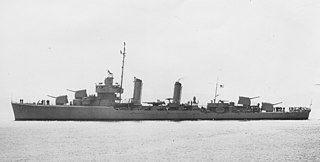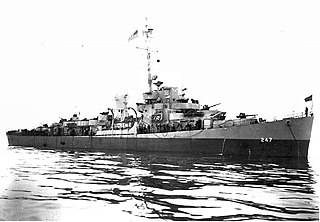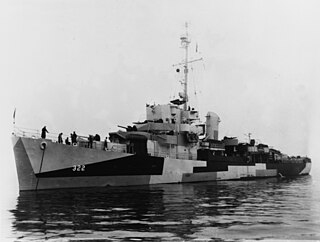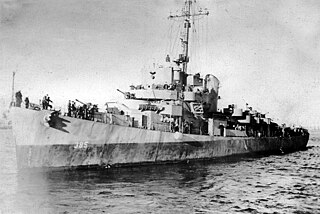
Mahan-class destroyers of the United States Navy were a series of 18 destroyers of which the first 16 were laid down in 1934. The last two of the 18, Dunlap and Fanning, are sometimes considered a separate ship class. All 18 were commissioned in 1936 and 1937. Mahan was the lead ship, named for Rear Admiral Alfred Thayer Mahan, an influential historian and theorist on sea power.

USS Abercrombie (DE-343) was a John C. Butler-class destroyer escort in the service of the United States Navy from 1944 to 1946. She was finally sunk as a target in 1968.

USS Goldsborough (DD-188/AVP-18/AVD-5/APD-32) was a Clemson-class destroyer in the United States Navy during World War II. She was the second Navy ship named for Rear Admiral Louis M. Goldsborough (1805–1877). Entering service in 1920, the ship had a brief active life before being placed in reserve in 1922. Goldsborough was reactivated for World War II and was used as an aircraft tender, destroyer and high speed transport in both Atlantic and Pacific theaters. Following the war, the ship was sold for scrapping in 1946.
USS Dallas (DD-199) was a Clemson-class destroyer in the United States Navy during World War II. She was the second ship named for Captain Alexander J. Dallas, and was later renamed Alexander Dallas.

USS Mervine (DD-489/DMS-31), a Gleaves-class destroyer, was the second ship of the United States Navy to be named for Rear Admiral William Mervine, who served during the War of 1812, the Mexican–American War and the American Civil War. Mervine was laid down on 3 November 1941 by the Federal Shipbuilding & Dry Dock Company of Kearny, New Jersey and launched on 3 May 1942, sponsored by Miss Mildred Mervine great-granddaughter of the admiral. The ship was commissioned on 17 June 1942.

USS Carmick (DD-493/DMS-33), a Gleaves-class destroyer, was the only ship of the United States Navy to be named for Major Daniel Carmick (1772–1816), an officer in the United States Marine Corps who served during the Quasi-War with France and during the War of 1812.

USS Warrington (DD-383) was a Somers-class destroyer, laid down on 10 October 1935 at Kearny, New Jersey, by the Federal Shipbuilding and Drydock Company; launched on 15 May 1937; sponsored by Miss Katherine Taft Chubb; and commissioned at the New York Navy Yard on 9 February 1938.

USS Weeden (DE-797) was a Buckley-class destroyer escort in service with the United States Navy from 1944 to 1946 and from 1950 to 1958. She was scrapped in 1969.

USS Foss (DE-59) was a Buckley-class destroyer escort of the United States Navy, in service from 1943 to 1957. She was sunk as a target in September 1966.

USS Solar (DE-221), a Buckley-class destroyer escort of the United States Navy, was named in honor of Boatswain's Mate First Class Adolfo Solar (1900–1941), who was killed in action during the Japanese attack on Pearl Harbor on 7 December 1941.

USS W.S. Sims (FF-1059) was a Knox-class frigate of the United States Navy named for William Sims. She was in commission from 1970 to 1991.

USS Witek (DD/EDD-848) was a Gearing-class destroyer of the United States Navy, named for Marine Private First Class Frank P. Witek (1921–1944), who was awarded the Medal of Honor posthumously for his heroism during the Battle of Guam.

USS Stewart (DE–238) is an Edsall-class destroyer escort, the third United States Navy ship so named. This ship was named for Rear Admiral Charles Stewart, who commanded USS Constitution during the War of 1812. Stewart is one of only two preserved destroyer escorts in the U.S. and is the only Edsall-class vessel to be preserved. She is on display in Galveston, Texas as a museum ship and is open to the public.

USS Stanton (DE-247) was an Edsall-class destroyer escort built for the U.S. Navy during World War II. She served in the Atlantic Ocean the Pacific Ocean and provided destroyer escort protection against submarine and air attack for Navy vessels and convoys.

USS Harveson (DE-316) was an Edsall-class destroyer escort built for the U.S. Navy during World War II. She served in the Atlantic Ocean the Pacific Ocean and provided destroyer escort protection against submarine and air attack for Navy vessels and convoys.

USS Kretchmer (DE-329) was an Edsall-class destroyer escort built for the U.S. Navy during World War II. She served in the Atlantic Ocean and the Pacific Ocean and provided destroyer escort protection against submarine and air attack for Navy vessels and convoys.

USS Newell was an Edsall-class destroyer escort built for the U.S. Navy during World War II. She served in the Atlantic and Pacific Oceans and provided destroyer escort protection against submarine and air attack for Navy vessels and convoys. Post war, she served in various capacities before being finally decommissioned.

USS Strickland (DE-333) was an Edsall-class destroyer escort in service with the United States Navy from 1944 to 1946 and from 1952 to 1959. She was sold for scrapping in 1974.

USS Richey (DE-385) was an Edsall-class destroyer escort built for the U.S. Navy during World War II. She served in the Atlantic Ocean and the Pacific Ocean and provided destroyer escort protection against submarine and air attack for Navy vessels and convoys.

USS Neunzer (DE-150) was an Edsall-class destroyer escort in service with the United States Navy from 1943 to 1947. After spending several decades in reserve, she was sold for scrap in 1973.



















